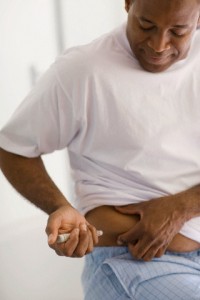(ThyBlackMan.com) While diabetes and prediabetes occur in people of all ages and races, some groups have a higher risk for developing the disease than others. Diabetes is more common in African Americans, Latinos, Native Americans, and Asian Americans/Pacific Islanders, as well as the aged population. This means they are also at increased risk for developing prediabetes.
Before most people develop full-blown diabetes, they likely suffer from prediabetes, a condition in which blood sugar is higher than normal but not so high that an individual is considered diabetic.
People with prediabetes are at greater risk for heart disease, and as many as 65 percent of prediabetics go on to develop type 2 diabetes. The problem is that very few people know they have it. 
There are three different tests your doctor can use to determine whether you have prediabetes:
- The A1C test
- The fasting plasma glucose test (FPG)
- or the oral glucose tolerance test (OGTT)
The blood glucose levels measured after these tests determine whether you have a normal metabolism, or whether you have prediabetes or diabetes.
If your blood glucose level is abnormal following the FPG, you have impaired fasting glucose (IFG); if your blood glucose level is abnormal following the OGTT, you have impaired glucose tolerance (IGT). Both are also known as prediabetes.
If you fall into a risk group for diabetes, take some steps to find out if you have prediabetes, and to prevent it from developing into full-fledged diabetes:
1. Get tested.People with prediabetes won’t suffer any obvious physical symptoms of the disorder, Tobin says, and the only way to determine whether you have it is with a glucose tolerance test. The most accurate test is an oral glucose tolerance test, which is used less frequently than the cheaper, less accurate, fasting glucose tolerance test.
2. Get to the doctor. In order to get tested, you have to visit your doctor regularly. The tests are usually performed during an annual physical, but one characteristic among patients in this study who had prediabetes is that 17 percent had not been to a doctor in the previous year.
3. Don’t live in denial. People at high risk for diabetes, whether they have prediabetes or not, are often in denial about it, Tobin says. But, she reiterates, “there is something you can do about this, and get really fantastic results.” If you’re genetically predisposed to diabetes or your doctor has suggested that you’re at risk, meet with a nutritionist who can help you find the best foods to treat diabetes, and start walking for 30 minutes every day. Fruits, vegetables, and exercise never landed anyone in the hospital!
Written by Karissa Lang




















If there is a condition called pre-diabetes, then we can envision a condition called pre-pre-diabtes. In other words, maybe we should all eat healthier to preserve our health. As the writer sagely advises, “start walking for 30 minutes every day. Fruits, vegetables, and exercise never landed anyone in the hospital!”